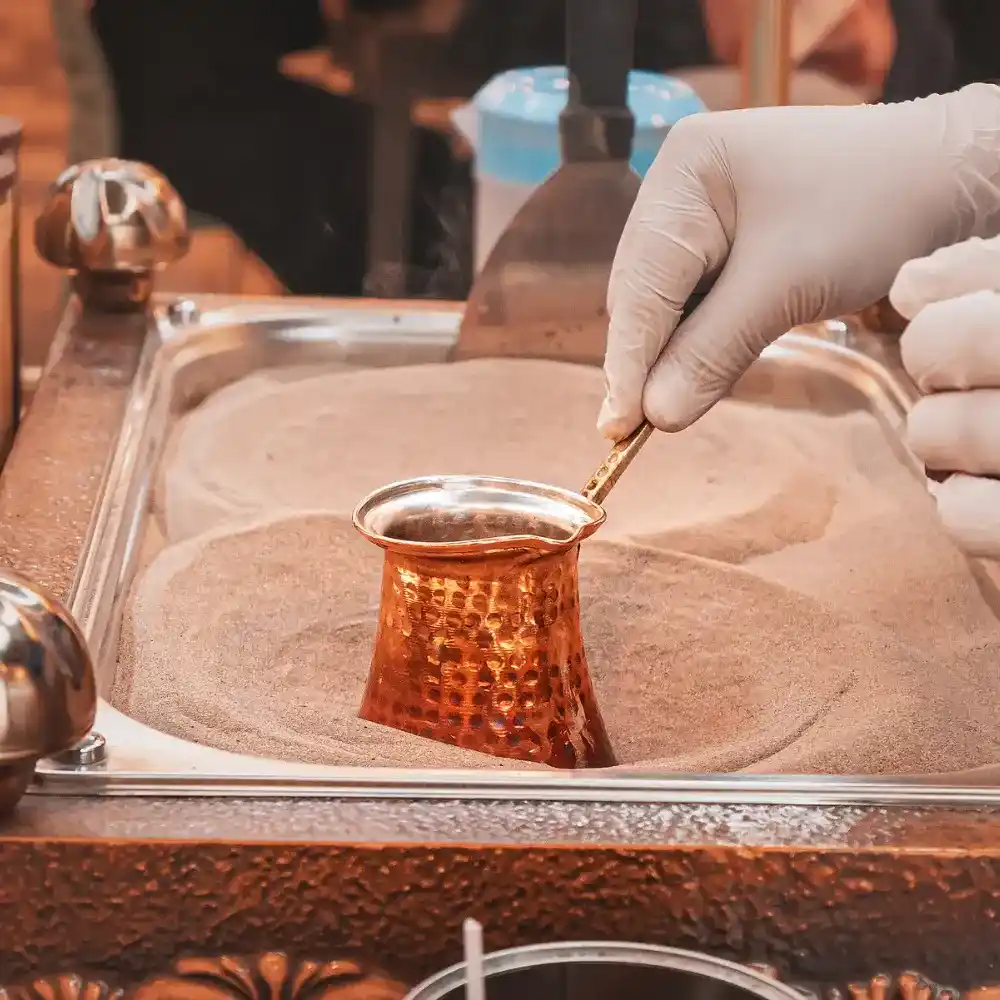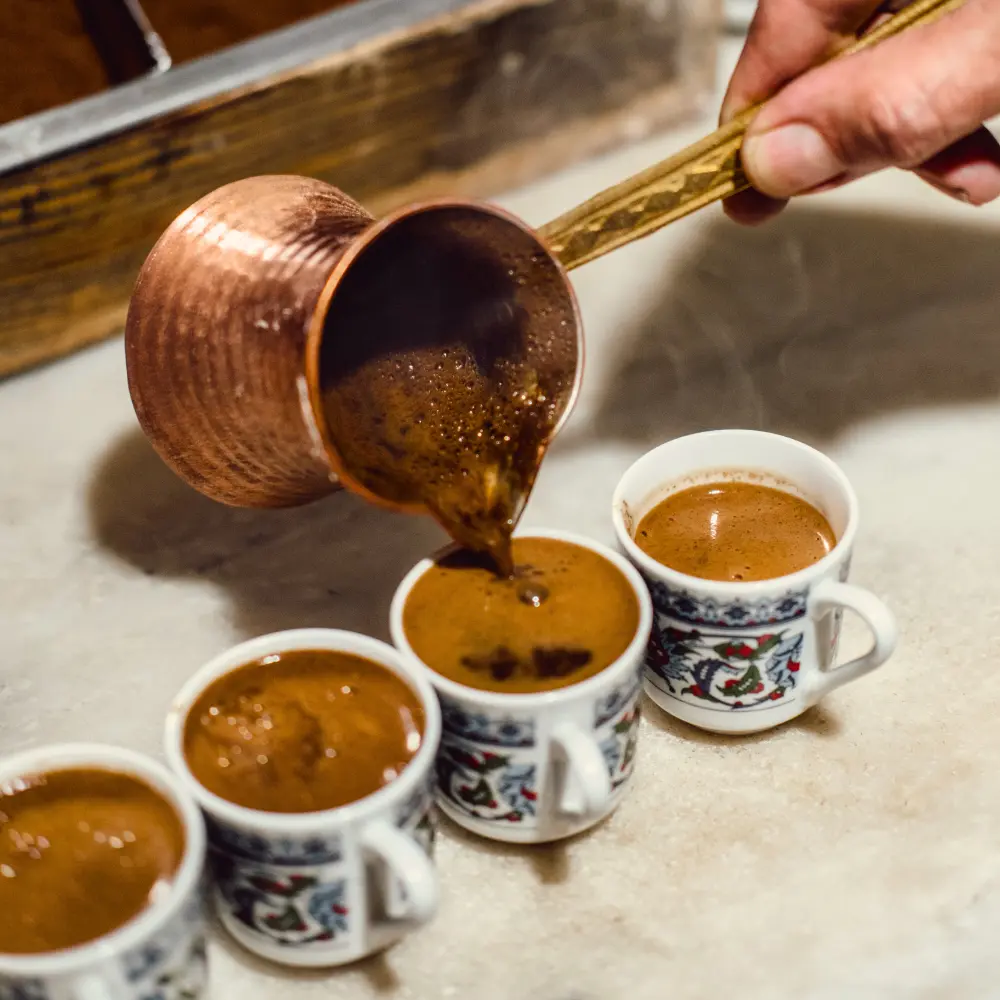Welcome to the world of Turkish sand coffee, a captivating realm where centuries-old tradition, intriguing rituals, and enticing flavors meet. Beyond a mere beverage, Turkish coffee, especially when brewed in sand, represents a distinct facet of Turkish culture, underscoring the country’s rich history and vibrant social life.
In this comprehensive guide, we will take a journey that explores the origins of this lovely beverage, its cultural significance, and its continued impact on the global coffee culture. We’ll delve into the unique brewing process that distinguishes it from other preparation methods, answering the common question: how does Turkish sand coffee work?
From understanding the brewing process to examining the best Turkish coffee sand machines, we aim to offer you an immersive look into this enduring tradition. By the end, you’ll have a deeper appreciation for Turkish coffee brewed in sand – not just as a strong, flavorful beverage, but as a symbol of hospitality, social interaction, and cultural identity that has stood the test of time. So, sit back, grab your cup, and join us as we embark on this aromatic journey.
Turkish Coffee in Sand: Key Takeaway
- A Cup of Heritage: Turkish sand coffee, a vital part of Turkey’s cultural heritage, signifies more than just a beverage; it symbolizes hospitality, friendship, and social interaction dating back to the Ottoman period.
- Brewing Distinction: The unique method of brewing Turkish coffee in sand sets it apart from regular brewing methods, utilizing the heat control provided by sand, finely ground coffee, and a layer of foam.
- Savor the Flavor: The brewing process for this concoction offers a unique taste and texture to the beverage, creating a strong, aromatic cup of joe with a rich foam on top – an experience unlike any other.
- Sand’s Role in Brewing: Sand plays a pivotal role in the preparation of this drink, serving as a heat buffer that ensures uniform heat distribution and allows for a consistent brewing process.
- Symbolic Sips: In traditional ceremonies, this delectable beverage holds a significant place. It is not only a beverage but a medium of fostering social bonds, signifying deep connection and hospitality.
Origins of Turkish Sand Coffee
The intriguing story of this concoction starts in the heart of the Ottoman Empire. It carries forward a rich tradition and has had an indelible impact on the global coffee culture. This method, often referred to as “Turkish coffee in sand,” presents a fascinating blend of history, culture, and influence.
Historical Significance

The historical significance of this beverage cannot be overstated. Introduced around the 16th century, this brewing technique quickly became a cornerstone of Ottoman culture. The primary distinguishing factor was the method of preparation. Instead of directly applying heat to the pot, the Ottomans used heated sand, providing a consistent and gentle warmth to the brew.
This method not only added a unique aesthetic to the process but also resulted in a distinctively rich, frothy cup of joe. Over time, it became an integral part of Turkish culture, gaining popularity across the empire and beyond. Even today, this delectable drink is a cherished tradition, serving as a connection to the past and a testament to the region’s rich culinary history.
Coffeehouses in Ottoman Society: Centers of Socialization
The proliferation of coffeehouses, known as “Kahvehane,” in Ottoman society solidified the status of coffee as an essential social and cultural fixture. These coffeehouses were not merely places to consume coffee; they were centers for social interaction, intellectual debate, and artistic expression. (1)

In these lively venues, people gathered to play chess or backgammon, discuss literature and philosophy, and listen to poets and musicians. The vibrant coffeehouse culture of the Ottoman era reflected the importance of communal bonds, promoting a shared sense of belonging and identity among its patrons.
Interestingly, coffeehouses also played a key role in the widespread adoption and popularity of this beverage-brewing method. These places provided an ideal setting to showcase the visually striking process of brewing Turkish sand coffee, thus making the experience not just about taste, but also about spectacle and camaraderie.
Cultural Importance
As discussed, this concoction is deeply embedded in the cultural fabric of Turkey. It goes beyond being a mere beverage, it’s a symbol of hospitality, an ice-breaker, and a catalyst for conversation. Here are some ways this unique brewing method has permeated Turkish culture:
- Hospitality: Offering this drink to guests is seen as a warm gesture of welcome. The process of brewing the coffee in sand provides a spectacle that adds to the overall experience.
- Socialization: Brewing and enjoying this beverage is a social activity. It promotes dialogue, fosters relationships, and creates a sense of community.
- Fortune telling: An intriguing tradition associated with this lovely drink is the practice of tasseography, or fortune-telling by reading the grounds. This is done after the coffee is consumed and adds a mystical element to the experience.
Influence on Modern Coffee Culture
The influence of this concoction on the global coffee scene is noteworthy. Its unique brewing method inspired experimentation and sparked interest in alternative brewing techniques around the world. Today, it’s not uncommon to see modern cafes and restaurants adopting this traditional brewing technique, appreciating it for both the sensory delight it provides and the exceptional flavor profile of the coffee it produces.
Furthermore, Turkish sand coffee has also gained recognition from UNESCO, which included Turkish coffee culture and tradition in its list of Intangible Cultural Heritage of Humanity in 2013. This acknowledgment further solidifies the global influence and importance of this beverage, marking its place in the annals of global coffee history. (2)
How Does Turkish Sand Coffee Work? – The Brewing Process

When it comes to this concoction, the magic lies in the method. The traditional brewing process is an art form in itself, requiring precision, patience, and a touch of flair. But, how does Turkish sand coffee work? It starts with the right ingredients, the correct tools, and equipment, and finally, mastering the art of preparation.
Traditional Ingredients
The core ingredients of this delightful beverage are simple yet specific. Here’s what you need:
- Coffee Beans: Turkish coffee traditionally uses Arabica beans. The beans are ground to a very fine powder, finer than espresso. The grind is crucial as it influences the extraction of flavors and the texture of the coffee.
- Sugar: The amount of sugar varies depending on personal preference. Turkish coffee can be ‘unsweetened’ (sade), ‘a little sugar’ (az şekerli), ‘medium sugar’ (orta), or ‘sweet’ (şekerli).
- Water: The water used in this drink should be cold and soft. The amount of water usually depends on the size of the cup.
- Optional Spices: Some variations of this beverage include spices such as cardamom or cloves for added aroma and flavor.
Tools and Equipment

The brewing process of this concoction requires some specialized tools:
- Cezve/Ibrik: This is a small, long-handled pot traditionally made of brass or copper. Its shape allows the coffee to froth up perfectly.
- Sand Tray: A tray filled with sand is heated, usually over an open flame. The sand provides a consistent and controlled heat source.
- Turkish Coffee Cups (Fincan): Smaller than a regular cup, these cups are designed to hold the rich, frothy coffee and its sediment.
Mastering the Art of Preparation

Preparing this beverage is a multi-step process that requires attention to detail:
- Combine Ingredients: The coffee, sugar (if used), and cold water are added to the Cezve.
- Heat the Sand: The sand in the tray is heated until it reaches the right temperature.
- Brew the Coffee: The Cezve is then buried in the hot sand. The heat from the sand causes the coffee to froth. The Cezve is removed from the sand just before it starts to boil over.
- Serve Immediately: The coffee is then immediately poured into small cups, ensuring that the froth is evenly distributed.
Brewing this delightful drink is a delicate balance of science and art, a ritual that reflects Turkey’s rich cultural heritage. While mastering this traditional method takes practice, the end result is a flavorful, aromatic cup of joe that’s truly worth the effort.
The Science Behind Turkish Sand Coffee
Beyond the traditional and cultural appeal of Turkish sand coffee, there’s an intriguing science that contributes to its unique characteristics. The process of brewing Turkish coffee in sand involves interesting aspects of heat transfer, extraction, and foam formation. For those looking to recreate the experience at home or in a café setting, understanding these aspects can be quite beneficial, especially when using a Turkish coffee sand machine.
Heat Transfer and Extraction

The use of sand in brewing Turkish coffee is not merely for spectacle; it’s a scientific method designed to deliver the perfect heat transfer for optimal extraction.
Sand, owing to its fine grains and high specific heat capacity, can maintain and distribute heat more evenly than water or air. When a cezve (the small pot used to brew Turkish coffee) is buried in heated sand, the heat envelops the pot uniformly, allowing the coffee inside to be heated at an even rate.
This uniform heat distribution plays a key role in the extraction of flavors from the grounds. The slow, steady heat extracts the subtle flavors and aromatic compounds in the coffee without over-extraction, which can lead to a bitter taste.
The Role of Finely Ground Coffee
In this beverage preparation, the beans are ground to a very fine powder, even finer than espresso. This fine grind is integral to the unique texture and flavor profile of Turkish coffee.

A finer grind means more surface area of the coffee is exposed to the water, allowing for a thorough extraction of the flavors. This results in a strong, full-bodied cup of joe that retains the nuanced flavors of the beans.
Furthermore, the fine grounds settle at the bottom of the cup, creating a thick layer of sludge known as the “telve.” Though not typically consumed, the telve plays an essential role in the traditional practice of Turkish fortune-telling.
Understanding Foam Formation
One of the defining features of this concoction is its thick, velvety layer of foam. This foam is not merely a visual treat, but it also contributes to the coffee’s texture and taste.
The foam formation is a result of the brewing process. When the coffee in the cezve is heated, it begins to froth. The even heat provided by the sand facilitates a steady rise of the foam, and just before it begins to boil over, the cezve is removed from the heat, preserving the foam.

The foam adds a rich, creamy mouthfeel taste, enhancing its overall sensory experience. In fact, in traditional Turkish culture, the quality of the foam is often used as an indicator of the brewer’s skill – the more stable and plentiful the foam, the better the coffee.
The science behind this delectable beverage is a fascinating blend of physics and chemistry, contributing to the unique qualities that set it apart in the world of coffee. Whether you’re brewing it with a traditional sand tray or a modern Turkish coffee sand machine, understanding these scientific aspects can help you achieve the perfect brew.
Flavors and Aromas
Turkish sand coffee’s unique brewing method yields an unparalleled sensory experience, where the flavors and aromas are front and center. It introduces a taste profile that’s incredibly distinct and has the potential for varied customizations. Furthermore, when it comes to coffee pairing, this lovely drink and Turkish delight make a truly delightful match.
Unique Taste Profile
The flavor profile of this concoction is remarkably distinct. The combination of slow brewing and fine grounds creates a concentrated, full-bodied brew with rich aromas and intense flavors. The slow heat extracts the subtle flavors from the coffee, creating a robust cup that’s thick and aromatic.

Additionally, the foam that forms on top adds a creamy texture and a slightly sweet note to the coffee, enhancing the overall flavor. The sediment that settles at the bottom of the cup, while usually left unconsumed, contributes to the coffee’s unique texture and depth of flavor.
Variations and Customizations
While traditional Turkish sand coffee is a delight in its own right, there’s ample room for variations and customizations. For those who enjoy experimenting with flavors, spices like cardamom, cloves, or cinnamon can be added during the brewing process to impart additional complexity to the brew.
Another variable in the flavor profile of this beverage is sugar. While the traditional method calls for no sugar, adding it to the brew can balance the intense flavors of the coffee and add a touch of sweetness.
It’s also common in some regions to add a drop of cold water to the cup before serving. This causes the fine coffee particles to sink, reducing the amount of sediment in the final sip.
Pairing Turkish Sand Coffee with Delightful Treats

A cup of this beverage is often enjoyed with a side of Turkish delight, a pairing that offers a wonderful balance of intense coffee flavors and sweet, chewy confection. Turkish delight, or ‘lokum,’ comes in a variety of flavors, from rose to pomegranate, each complementing the strong, rich taste of the coffee.
Additional common combinations involve baklava, a delectable pastry comprising multiple layers of filo dough stuffed with finely chopped nuts and drizzled with syrup or honey. Similarly, there’s borek, a savory pastry brimming with either cheese or minced meat. These pairings not only provide a delicious contrast to the strong coffee but also create a full, satisfying culinary experience.
Whether you’re a coffee connoisseur or a casual enthusiast, exploring the flavors and aromas of this delightful drink provides an exciting journey into a centuries-old tradition. It’s an opportunity to engage with a different culture, experimenting with flavors, trying new pairings like coffee and Turkish delight, and delighting in the sensory experience of this unique brew.
Best Turkish Sand Coffee Machines
The authentic flavor of Turkish coffee is best achieved with the use of traditional sand coffee machines. These devices incorporate ancient brewing techniques with modern conveniences, ensuring a perfect cup every time. Let’s explore three top-rated Turkish coffee sand machines, each offering unique features to enhance your brewing experience.
Sudamlasibazaar – Small Copper Sand Coffee Brewer Machine

A compact yet efficient device, the Small Copper Sand Coffee Brewer Machine by Sudamlasibazaar is an excellent choice for Turkish coffee lovers. Designed for home use, this machine brings the authentic Turkish brewing experience right into your kitchen.
- Dimensions: 6.30 x 7.10 x 7.90 inches
- Weight: 1600 grams
- Capacity: Accommodates 2-3 copper pots, brewing 4-6 servings simultaneously
- Voltage: Operates at 110-220 Volts, includes a converter plug for American outlets
- Extras: Comes with a complimentary copper pot
The Sudamlasibazaar machine captures the essence of traditional Turkish brewing while adapting to modern kitchen settings, making it a favorite among enthusiasts.
KuVav Cups – Copper Sand Coffee Machine

The Copper Sand Coffee Machine by KuVav Cups combines elegance and functionality. Designed for larger gatherings, this machine is known for its fast brewing process and significant capacity.
- Dimensions: 14.20 inches by 6.30 inches by 11.40 inches
- Weight: 9 kg (with sand)
- Brewing Speed: Brews Turkish coffee in less than a minute
- Capacity: Accommodates 6 sizable Turkish coffee pots, brewing over 25 servings simultaneously
- Features: Comes with signal lights for easier monitoring
The KuVav Cups machine offers a seamless blend of tradition and modernity, guaranteeing an extraordinary experience for your guests.
Sudamlasibazaar – Large Turkish Coffee Sand Machine

Perfect for large-scale brewing, the Large Turkish Coffee Sand Machine by Sudamlasibazaar is a centerpiece of any kitchen or café.
- Dimensions: 7 x 11 x 21 inches
- Capacity: Accommodates 15 copper pots, brewing up to more than 30 servings simultaneously
- Voltage: Operates at 110-220 Volts, includes a converter plug for American outlets
- Extras: Comes with a complimentary copper pot
This robust machine not only delivers excellent Turkish coffee but also adds a touch of authenticity to your space, making it the best Turkish coffee sand machine for commercial use or large gatherings.
Embracing Turkish Coffee Culture
Turkish culture extends far beyond the unique brewing methods and the rich, bold flavors. It delves into a social landscape of traditional coffeehouses, gatherings, and time-honored rituals such as Turkish coffee fortune-telling. These practices form the very fabric of Turkish society, preserving a legacy steeped in rich heritage and tradition.
Traditional Coffeehouses and Gatherings
As mentioned before, in Turkey, coffee is more than just a beverage—it’s a social institution. Traditional coffeehouses, known as ‘kahvehane,’ have long been the nerve centers of socialization, conversation, and community engagement.

Often frequented by men, these coffeehouses are places where locals gather to discuss everything from politics to soccer, play board games, and enjoy music and performances. The central fixture of these gatherings is, of course, Turkish coffee. Brewed in sand and served with great ceremony, the coffee signifies hospitality, camaraderie, and shared moments of relaxation.
Rituals and Etiquette

Alongside the sociable nature of coffee drinking in Turkey, several rituals and etiquette principles surround this treasured beverage.
As discussed earlier, one intriguing tradition associated with Turkish coffee is fortune telling, known as ‘tasseography.’ Once you finish drinking, the cup is flipped over onto the saucer and allowed to cool. The shapes and patterns formed by the grounds are then interpreted to predict the drinker’s future.
Moreover, how you take your cup of joe—unsweetened, a little sugar, medium sugar, or sweet—can be a personal statement.
Symbolism in Turkish Wedding Customs
Turkish coffee holds a special place not only as a popular beverage but also as a significant element in the traditional Turkish wedding customs. It plays a pivotal role in the prelude to marriage, where the parents of the groom, accompanied by an elder family member in the absence of the father, pay a visit to the young girl’s family. Their purpose is twofold: to seek the hand of the bride-to-be and to receive the blessings of her parents for the forthcoming union.
Exploring the Coffee Test: Gauging the Groom’s Character
During this auspicious meeting, an important ritual takes place— the bride-to-be takes on the task of preparing and serving Turkish coffee to the esteemed guests. Interestingly, the bride-to-be adds a subtle twist to the coffee intended for the groom. Instead of sweetening it with sugar, she occasionally uses a pinch of salt, which serves as a subtle test of his character. By observing his reaction to the unconventional taste, the bride-to-be aims to gauge the groom’s disposition. If he sips the coffee without displaying any hint of displeasure, it signifies to her that he possesses a good-tempered and patient nature.
While the groom arrives at the girl’s house as the party seeking marriage, it is he who finds himself undergoing an examination. As per the prevailing etiquette, it is expected of him to graciously accept this unique offering from the girl and receive it with a smile. Thus, the act of drinking the coffee acts as a symbolic representation of the groom’s ability to embrace challenges with composure and display the appropriate decorum in this delicate situation.
Preserving the Legacy
Today, the tradition of Turkish coffee culture is preserved and promoted through a combination of modern establishments and cultural advocacy. New-generation coffeehouses and cafes honor the legacy while adapting to contemporary tastes and trends.
As mentioned before, in 2013, UNESCO recognized Turkish coffee culture and tradition as an Intangible Cultural Heritage of Humanity, underlining its cultural importance. This recognition has helped raise awareness and appreciation of the rich history, rituals, and social significance of Turkish coffee worldwide.
Embracing Turkish coffee culture is about more than enjoying a flavorful brew—it’s about partaking in a centuries-old legacy, steeped in tradition, etiquette, and community. Whether it’s the socialization in traditional coffeehouses, the rituals like Turkish coffee fortune telling, or the efforts to preserve the legacy, the culture surrounding this beverage offers a fascinating insight into the rich tapestry of Turkish society.
Turkish Sand Coffee Today: Modern Interpretations and Global Influence
The tradition of brewing Turkish coffee in sand has traveled far beyond the borders of Turkey, with modern interpretations and global influence allowing this ancient art to thrive in the 21st century. Contemporary variations, international Turkish sand coffee houses, and a new generation of coffee lovers inspired by this unique method have all contributed to its continued popularity and evolution.
Contemporary Variations of Turkish Sand Coffee

Modern-day innovations have given rise to a range of contemporary variations of this delightful beverage. From updated recipes incorporating different spices, sweeteners, and types of coffee beans, to creative presentation methods, Turkish coffee has evolved while still respecting its historical roots.
For example, some cafes now offer vegan versions of Turkish coffee using plant-based milks, while others experiment with infusions of unique flavors like lavender or orange blossom. The advent of advanced brewing equipment like electric Turkish coffee sand machines has made it easier to control the heat during brewing, resulting in consistent and flavorful cups every time.
Turkish Sand Coffee Houses around the World
The global influence of this concoction is evident in the increasing number of coffee houses serving this traditional brew in cities around the world. These establishments often reflect the cultural aesthetics of traditional Turkish coffee houses, creating an inviting atmosphere that honors the centuries-old tradition of socialization and leisurely coffee consumption.

From New York to Sydney, London to Dubai, you can find cafes serving Turkish coffee in sand, often alongside traditional Turkish treats like Turkish delight and baklava. These venues serve as cultural hubs, introducing people to the rich flavors and communal experience of Turkish culture.
Turkish Sand Coffee: Inspiring a New Generation of Coffee Lovers
This delectable drink has resonated with a new generation of coffee enthusiasts who value both the flavor and the story behind their brew. The unique preparation method, the slow and mindful enjoyment, and the social customs associated with Turkish coffee have struck a chord with those looking for more than just a caffeine fix.
The ceremonial aspect of brewing and serving Turkish coffee in sand appeals to the trend of mindfulness and slow living, while the robust flavor and rich history add depth to the coffee-drinking experience. Social media platforms are brimming with photos and videos of this concoction, further increasing its popularity among younger coffee lovers.
In a world of quick coffee pods and instant brews, the enduring tradition of this lovely beverage stands as a testament to the idea that some things are worth taking time over. Its modern interpretations and global influence ensure that this centuries-old tradition continues to thrive, offering a unique, richly flavored alternative in the diverse world of this beverage.
Conclusion
As we bring this aromatic journey to a close, it’s clear that the world of Turkish sand coffee extends far beyond the confines of a simple beverage. This centuries-old tradition, steeped in cultural symbolism and social significance, presents a fascinating fusion of history, culinary art, and the simple joy of savoring a meticulously prepared cup of joe.
Throughout this guide, we’ve explored the heart of Turkish coffee culture, delved into its captivating history, and witnessed how Turkish coffee in sand has influenced cultures around the globe. We’ve unraveled the intricacies of the brewing process, answering the intriguing question of how does Turkish sand coffee work, and introduced you to some of the best Turkish coffee sand machines that bring this authentic brewing method into modern kitchens.
We hope that this exploration has not only expanded your knowledge of this delightful drink but also inspired a deeper appreciation for its unique taste and the rituals surrounding its preparation. As you sip your next cup of Turkish coffee, remember the rich history and cultural significance it holds, and let it be a reminder of the universal language of hospitality and connection that coffee represents.
In the end, Turkish sand coffee is more than a beverage—it’s a testament to a resilient and vibrant culture, a timeless symbol of hospitality, and a ritual that brings people together, one cup at a time.
FAQ
What are the key differences between regular coffee brewing methods and the Turkish sand coffee method?
The key differences between regular coffee brewing and the Turkish sand coffee method are the use of extremely fine coffee grounds, the presence of a layer of foam, and the unique heat control provided by sand.
How does the brewing method affect the taste and texture of Turkish sand coffee?
The brewing method for this concoction contributes to its distinct taste and texture by allowing for a slow extraction process that enhances the flavor and results in a fine foam on top.
What role does sand play in brewing Turkish sand coffee?
Sand in Turkish sand coffee brewing acts as a heat buffer, ensuring uniform heat distribution, which allows for a controlled and consistent brewing process.
What is the symbolism of Turkish sand coffee in traditional ceremonies?
Turkish sand coffee holds symbolic importance in traditional ceremonies, signifying hospitality, deep connection, and a means of fostering social bonds.




















1 comment
Amazing 🔥🔥